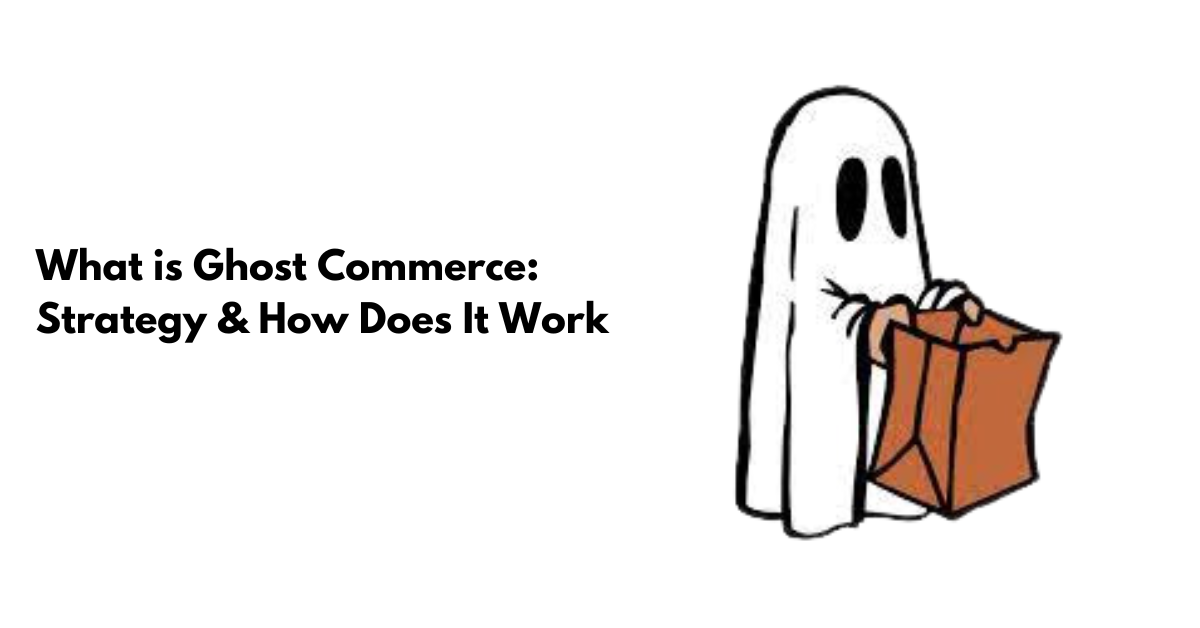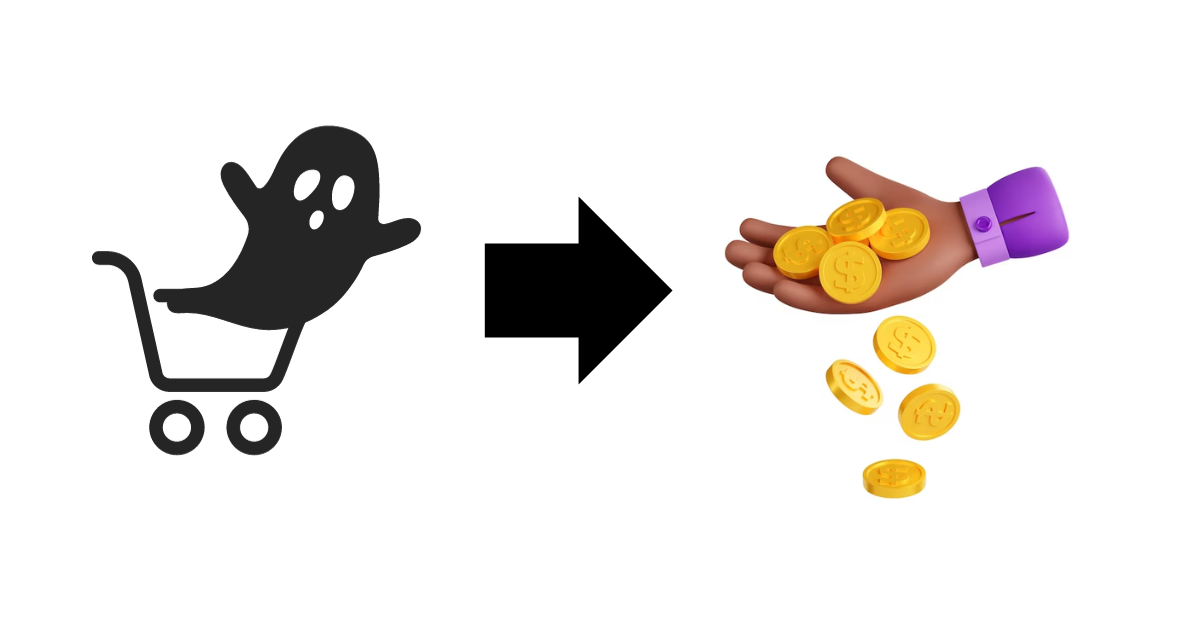What is Ghost Commerce: Strategy & How Does It Work In 2024

Have you ever tried shopping online without stepping foot in a physical store?
Ghost commerce, in which goods and services are sold exclusively in the digital world without any physical inventory, opens up a whole new world of possibilities.
This is achieved by utilizing external platforms like Printify or Printful to handle orders. Ghost commerce is becoming increasingly popular because of its ease of entry and rapid scalability. It is especially appealing to entrepreneurs who prefer to concentrate on advertising and branding rather than operational tasks. In this article, we will delve into the ghost commerce strategy and its potential as the next big thing in e-commerce.
What is Ghost Commerce

Ghost commerce means to a retail strategy where businesses operate without a physical storefront or traditional online presence like a dedicated e-commerce website. Instead, these businesses use third-party platforms such as social media, marketplaces, or mobile apps to conduct transactions.
The main appeal of ghost commerce lies in its minimal overhead costs and flexibility. Businesses can quickly adapt to market trends and consumer preferences without the financial burden associated with maintaining a physical or even a traditional online store. This model is particularly popular among startups and small businesses looking to capitalize on the vast reach of digital platforms without significant upfront investments.
How does Ghost Commerce work?
Ghost commerce, also known as dropshipping, operates with the following key steps:
- Online Store Setup: The process begins with entrepreneurs setting up their online stores using e-commerce platforms like Shopify, WooCommerce, or Magento. They design their websites, add product listings, and create a seamless shopping experience for customers.
- Supplier Selection: In ghost commerce, entrepreneurs partner with third-party suppliers or manufacturers who offer dropshipping services. These suppliers stock the products and handle the inventory.
- Product Listing: Entrepreneurs select the products they want to sell from the supplier's catalog and list them on their online store. They can customize product descriptions, images, and pricing to match their brand.
- Customer Orders: When customers visit the online store and place orders, the entrepreneur's website captures the order details, including the customer's shipping address and payment information.
- Order Forwarding: The entrepreneur then forwards the order details to the selected supplier. This step can be automated through integration between the online store and the supplier's system.
- Supplier Fulfillment: The supplier receives the order information and processes it. They pick, pack, and ship the product directly to the customer on behalf of the entrepreneur. This includes generating shipping labels and handling any necessary customs documentation for international shipments.
- Customer Delivery: The customer receives the product, believing it was shipped by the online store. The packaging and branding may or may not include the name of the supplier, depending on the arrangement.
- Payment Handling: The entrepreneur collects the payment from the customer, typically receiving the retail price of the product. They pay the supplier the wholesale cost of the product, keeping the profit margin as revenue.
- Customer Support: The entrepreneur is responsible for providing customer support, handling inquiries, addressing concerns, and processing returns or refunds. Effective communication with customers is crucial for a positive shopping experience.
- Scaling the Business: As the business grows, entrepreneurs can add more products, expand marketing efforts, and optimize their online stores for better conversions. They can also diversify by partnering with multiple suppliers or exploring new product categories.
The Rise of Ghost Commerce
The emerging trend of invisible or behind-the-scenes e-commerce operations allows businesses to sell products without maintaining a traditional brick-and-mortar presence or even a visible online store. This model is primarily driven by third-party companies that handle everything from product listing to order fulfillment, effectively making the seller's role almost invisible to the consumer.
This trend is supported by the growing consumer preference for fast, efficient, and seamless purchasing experiences. As shoppers increasingly value convenience over brand loyalty, Ghost Commerce offers businesses the opportunity to tap into established platforms and distribution networks without the overhead associated with physical stores or extensive online operations.
This model also capitalizes on advanced logistics and technology solutions that can manage inventory, process orders, and deliver products with minimal input from the seller. The efficiency of Ghost Commerce allows businesses to focus on product development and marketing, rather than the complexities of e-commerce management. As this trend continues to develop, it is expected to significantly impact how companies approach the market and how consumers interact with brands
The Successful Ghost Commerce Strategy
A successful ghost e-commerce (dropshipping) strategy involves several key elements to maximize profitability and customer satisfaction. Here are some essential steps and considerations:
Niche Selection
- Research and select a niche that aligns with your interests, has a target audience and offers products with good profit margins.
- Conduct competitive analysis to identify market demand and competition within your chosen niche.
Supplier Research
- Find reliable suppliers or dropshipping partners with a proven track record of quality products and reliable order fulfillment.
- Consider factors like shipping times, shipping apps, product quality, and customer service when evaluating potential suppliers.
Online Store Setup
- Choose an e-commerce platform (e.g., Shopify, WooCommerce) that supports dropshipping and customize your online store.
- Create an appealing and user-friendly website with clear product listings, high-quality images, and compelling product descriptions.
Product Selection
- Carefully curate a selection of products that cater to your target audience's needs and preferences.
- Focus on offering unique or trending products to stand out from competitors.
Pricing Strategy
- Set competitive prices that cover your costs (product cost, shipping fees, marketing expenses) while providing room for profit.
- Consider offering discounts, bundles, or subscription options to entice customers.
Marketing and Promotion
- Develop a comprehensive digital marketing strategy, including SEO, social media marketing, email marketing, and paid advertising.
- Leverage content marketing to educate and engage your audience.
- Use social proof (reviews, testimonials) to build trust with potential customers.
Customer Service
- Provide excellent customer support to address inquiries, resolve issues, and process returns or refunds promptly.
- Offer multiple channels for customer communication, such as live chat, email, or a dedicated support team.
Inventory Management
- Monitor product availability with your suppliers and update your website's inventory in real-time to avoid overselling.
- Consider automating inventory management to reduce manual tasks.
Shipping and Delivery
- Clearly communicate shipping times and expectations to customers.
- Offer multiple shipping options, including expedited and international shipping, if possible.
- Manage shipping costs to balance competitive pricing with profitability.
Quality Control
- Continuously evaluate product quality and supplier performance.
- Address any quality issues promptly to maintain customer satisfaction.
Analytics and Optimization
- Track key performance indicators (KPIs), such as conversion rates, customer acquisition costs, and customer lifetime value.
- Use data-driven insights to optimize your product offerings, pricing, and marketing strategies.
Scale and Diversify
- As your business grows, consider expanding your product catalog, exploring new niches, or partnering with additional suppliers.
- Invest in marketing automation tools and outsourcing to streamline operations and scale efficiently.
Is Ghost Commerce Profitable?

Ghost e-commerce can be profitable, but it depends on a number of factors, including the products you sell, your marketing strategy, and your ability to manage your costs.
Here are some of the factors that can affect the profitability of a ghost commerce business:
- The type of products you sell: Some products are more profitable than others. For example, high-margin products, such as apparel and accessories, are generally more profitable than low-margin products, such as electronics.
- Your marketing strategy: A good marketing strategy is essential for any e-commerce business, but it is especially important for ghost commerce businesses. You need to be able to reach your target audience and convince them to buy your products.
- Your ability to manage your costs: Ghost commerce businesses can be profitable, but only if you are able to manage your costs effectively. This includes the cost of the products you sell, the cost of marketing, and the cost of fulfillment.
Here are some tips for increasing the profitability of your ghost commerce business:
- Choose high-margin products. This will give you more room to make a profit after you factor in the cost of marketing and fulfillment.
- Market your products effectively. You need to reach your target audience and convince them to buy your products. This can be done through paid advertising, social media marketing, and other channels.
- Manage your costs effectively. This includes the cost of the products you sell, the cost of marketing, and the cost of fulfillment. You can save money by negotiating discounts with suppliers, using free or low-cost marketing tools, and shipping products yourself.
- Provide excellent customer service. This will help you build customer loyalty and encourage repeat purchases.
Ghost Commerce by the Numbers
- In 2020, U.S. e-commerce sales reached $431.6 billion, marking a significant increase of 20% from the previous year.
- The ghost kitchen industry, a part of ghost commerce focusing on food delivery, is expected to expand to $1 trillion by 2030.
- By 2030, ghost kitchens are forecasted to account for 50% of the global market share for drive-thru and takeaway food services.
- E-commerce sales are projected to represent 24.5% of total global retail sales by 2025.
Ghost Commerce Case Studies
Here are some prominent examples of ghost commerce in practice:
- Uber: A leading transportation service, Uber operates without owning any vehicles.
- DoorDash: This service links customers with numerous dining choices but does not possess any restaurants or grocery stores.
- Ghost Kitchens: These are communal kitchens focused on delivery, allowing restaurants to grow their operations without establishing additional physical locations.
Why Ghost Commerce Could Be the Future of E-commerce?

Here are some of the reasons why ghost commerce could be the future of e-commerce:
- Low barriers to entry: Ghost commerce businesses can be started with little investment, making them a good option for entrepreneurs with limited resources.
- Scalability: Ghost commerce businesses can be scaled quickly and easily, as they do not require a large inventory or warehouse space.
- Focus on marketing and branding: Ghost commerce businesses can focus on marketing and branding, rather than on logistics, which can give them a competitive advantage.
- Invest in AI tools: AI is the future of ecommerce, investing in GPT-powered AI tools like Manifest AI can be a profitable choice for any brand.

- Increased demand for customization: Consumers are increasingly demanding customization, which is a good fit for ghost commerce businesses.
- Advances in technology: Advances in technology, such as print-on-demand apps and dropshipping, are making it easier for ghost commerce businesses to operate.
Ghost Commerce Examples
Here are some examples of ghost commerce businesses:
- Redbubble: Redbubble is a marketplace where artists can sell their designs on a variety of products, including t-shirts, posters, and mugs. Redbubble handles all of the fulfillment, so artists can focus on creating and marketing their designs.
- Teespring: Teespring is a print-on-demand company that allows anyone to create and sell custom t-shirts. Teespring handles all of the printing and shipping, so creators can focus on designing and marketing their t-shirts.
- Society6: Society6 is a marketplace where artists can sell their designs on a variety of products, including home décor, furniture, and wall art. Society6 handles all of the fulfillment, so artists can focus on creating and marketing their designs.
- Threadless: Threadless is a community-driven marketplace where anyone can submit designs for t-shirts. If a design is voted on by enough people, it will be printed and sold on Threadless. Threadless handles all of the fulfillment, so designers can focus on creating and marketing their designs.
- Zazzle: Zazzle is a print-on-demand company that allows anyone to create and sell custom products, including t-shirts, mugs, and phone cases. Zazzle handles all of the printing and shipping, so creators can focus on designing and marketing their products.
These are just a few examples of ghost commerce businesses. Many other businesses use this model, and the number is growing all the time.
Conclusion
Ghost commerce is a new e-commerce business model that is gaining popularity due to its low barriers to entry and its potential to scale quickly. It is also a good option for entrepreneurs who want to focus on marketing and branding, rather than on logistics.
While ghost commerce is not without its challenges, such as the need to find a reliable fulfillment partner and the need to build a strong brand, it has the potential to be a successful business model for entrepreneurs who are willing to put in the work.
FAQs
Here are the most frequently asked questions related to Ghost Commerce
Is Ghost Commerce legit?
Yes, ghost commerce is a legitimate business model. It is a way to sell products without having to invest in inventory or shipping. This is made possible by using third-party platforms, such as Printify or Printful, to fulfill orders.
What is Ghost Commerce retailer?
A ghost commerce retailer is a business that sells products without having a physical storefront. Instead, they rely on third-party platforms, such as print-on-demand or dropshipping, to fulfill orders. This allows them to start and run an e-commerce business with little investment and overhead.
How to make money with ghost commerce?
To make money with ghost commerce (dropshipping), follow these steps:
- Niche Selection: Choose a profitable niche with demand and good profit margins.
- Product Selection: Curate products that appeal to your target audience.
- Online Store: Set up an e-commerce website to showcase your products.
- Supplier Partnerships: Partner with reliable suppliers for product sourcing.
- Marketing: Implement effective digital marketing strategies to drive traffic and sales.
- Pricing: Price products competitively while ensuring profitability.
- Customer Service: Provide excellent customer support to build trust and repeat business.
- Efficient Operations: Optimize operations, automate tasks, and manage costs.
- Continuous Improvement: Monitor performance and adapt strategies to grow and maximize profits.
Ghost commerce vs Dropshipping?
Ghost commerce involves creating an online store and listing products without actually holding inventory. When a customer orders, the item is purchased from a third party and shipped directly to them. Dropshipping is similar but usually involves a formal agreement with suppliers to handle shipping and fulfillment. Both methods reduce the need for upfront inventory but dropshipping typically offers more reliability and supplier support.

.png)
